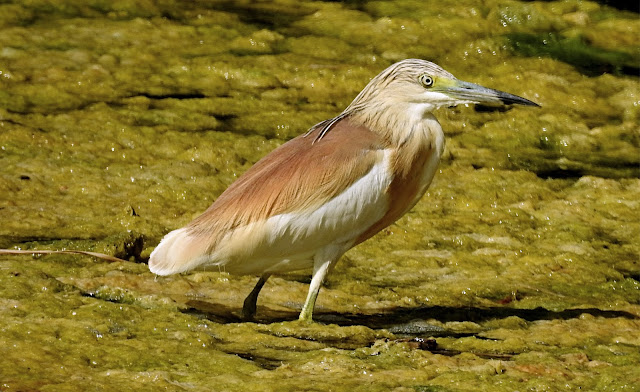The squacco heron is a migrant, wintering in Africa. It is rare north of its breeding range. The species has been recorded in Fernando de Noronha islands, and more rarely in mainland South America, as a vagrant. This is a stocky species with a short neck, short thick bill and buff-brown back. In summer, adults have long neck feathers. Its appearance is transformed in flight, when it looks very white due to the colour of the wings.
The squacco heron's breeding habitat is marshy wetlands in warm countries. The birds nest in small colonies, often with other wading birds, usually on platforms of sticks in trees or shrubs. Three to four eggs are laid. They feed on fish, frogs and insects.

The Squacco Heron uses freshwater localities throughout Europe and the Middle East as breeding grounds to later migrate south to the Sub-Saharan African region. Non-breeding Squacco Herons share similar traits with other heron species like the Indian Pond Heron and Malagasy Pond Heron which show tawny color plumage, lighter streaking, smaller bill, and narrower wing tips.
The squacco heron (Ardeola ralloides ) is a small heron, 44–47 cm (17+1⁄2–18+1⁄2 in) long, of which the body is 20–23 cm (8–9 in), with 80–92 cm (31+1⁄2–36 in) wingspan. It is of Old World origins, breeding in southern Europe and the Greater Middle East.
The English common name squacco comes via Francis Willughby (c. 1672) quoting a local Italian name sguacco. The current spelling comes from John Hill in 1752.
The scientific name comes from Latin ardeola, a small heron (ardea ), and ralloides, Latin rallus, a rail and Greek -oides, "resembling".
Widespread post-breeding dispersal of juveniles begins in July continuing until migration. Spring migration leads to frequent overshoots. So, outlying dispersal records are common. Dispersal records include Iceland, Britain (Moon 1997, Greason 1998), Belgium, Luxembourg, Netherlands, Denmark, Germany, Sweden, Finland, Austria, Poland, west central Asia, Azores, Madeira, the Canary and Cape Verde Islands, and Brazil (Fernando de Noronha island) (Nacinovic and Teixeira 1989). In the Indian Ocean, there are dispersal records from the Comores and Mauritus, undoubtedly from Madagascar.

Northern populations in Europe and west Asia are migratory. Southward migration is August–November, and appears to occur at a rather leisurely pace. Birds move in a broad front across Europe, the Middle East and the Sahara. Return migration is in February and March to as late as May. Migration appears to be along a broad front in that migrating birds are seen widely throughout the Mediterranean and its islands. Migration in both seasons crosses the Sahara.

The Squacco Heron is a tawny buff brown heron with a streaked head and back, and in breeding a black and white mane.
Adult: The adult nonbreeding Squacco Heron has a head that is finely streaked in black, brown, and grey, forming a modest crown but no elongated plumes in nonbreeding season. The relatively large and powerful bill is pale green yellow with a black tip and top. The lores are dull yellow green. The irises are yellow. The hind neck, like the head, is finely streaked in black, brown and grey. The upperparts are buff brown with slight tawny tinge. The wings are white and are mostly concealed at rest by the back plumes. The plumes are shorter than in the breeding season. The rump and tail are white. Foreneck and breast are bright buff coarsely streaked in dark brown. The remaining underparts are white. The relatively short legs and the feet are dull yellow green.

In breeding plumage, the upper parts become brighter and deeper. The crown is a mane of yellow buff or straw-colored feathers. The crown feathers are slightly elongated (1-5 cm) and are bordered with black. Several very elongated feathers (13-14 cm long) occur on the back of the crown. These are white bordered with black, and extend over the upper back. The lores are green or blue. The lower neck and back plumes are golden to cinnamon buff. The foreneck and breast are red gold. During courtship, the bill becomes bright blue except for the dark to black tip. The lores turn briefly blue before reverting via emerald to yellow green. The irises in courtship are richer yellow. The back is pink brown, with longest back feathers being golden and drooping over the wings. The legs are bright red in courtship, fading to pink after pairing. The other soft parts colors return to normal after the eggs are laid.
Variation: The sexes are alike. Geographic variation is not recognized taxonomically. South and central African birds were once considered recognized as the subspecies paludivaga.

Juvenile: The immature bird is similar to adults in nonbreeding, but drabber. It lacks the crest and back plumes. The bill is more uniform with a dark tip. The breast is more strongly streaked in dark brown. The underparts are grey rather than white. The flight feathers have a brown tinge and shafts, so that the wings appear to be mottled with brown. The tail also is washed with brown tint.
Chick: The chick has dark grey down, with long brown grey down on the head forming a crest. The irises are yellow and lores green yellow. The rest of the skin is olive green. The bill is yellow with a dark tip. The belly is naked for the first two weeks. Legs are olive green in the front and pale yellow behind.
Voice: The Squacco Heron is generally a quiet bird. The characteristic “Squawk” call, rendered variously as “caw”, “kak”, ‘rrra”, or “kak”, is given often at dusk, especially during breeding, as part of the Forward, and in flight. The call becomes a “kek, kek, kek, kek” in an aggressive Forward. “Grr” call, rendered “grrrr, grrrr, grrrr, grrrr”, is the alarm call. The young beg with “kri, kri, kri, kri”.
Weights and measurements: Length: 42-48 cm. Weight: 230-370 g.
%2020.jpg)
%2021.jpg)
%2022.jpg)


%20(Anas%20platyrhynchos)%2010.jpg)

%20(Passer%20domesticus)%2010.jpg)



%2010.jpg)
%2012.jpg)
%2010.jpg)
%2011.jpg)
%2012.jpg)









%2010.jpg)
%2011.jpg)




%2020.jpg)


%2020.jpg)
%2021.jpg)









%2020.jpg)
%2021.jpg)


%2010.jpg)